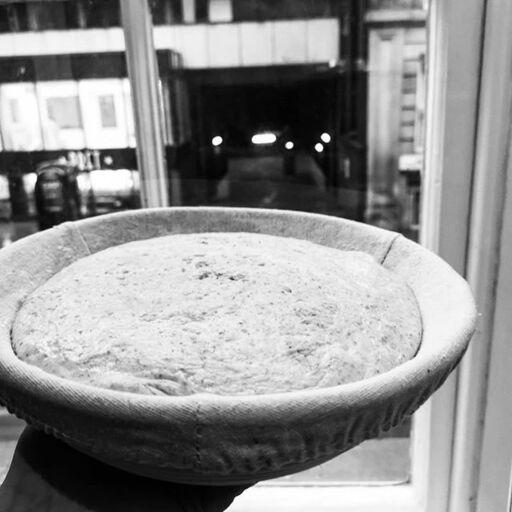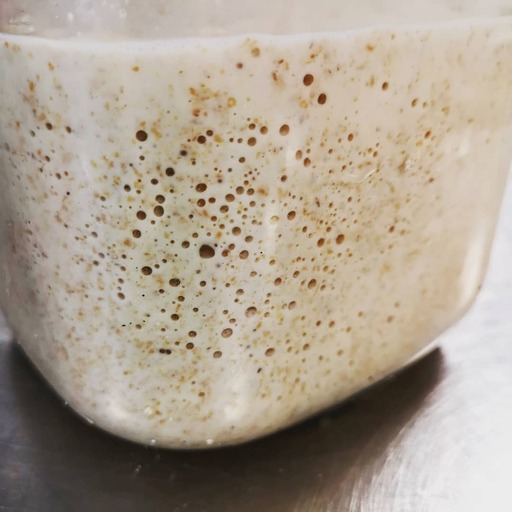
I have been caring for my starter for almost six months now, and I have to say I have loved every minute of looking after her. The ritual of feeding never tiers for me- get up, have my morning coffee, then me and my starter both have some breakfast. How to start your sourdough starter.
You’ll want to get yourself a tall jar with a secure lid. I prefer glass with a rubber sealed lid- but plastic will work just fine. Mix
- 150 strong white flour
- 150g rye or wholemeal flour
- 300g room temperature water
I like to mix by hand as the natural yeasts found on the skin help to kick start the fermentation process. Mix until there are no lumps of loose flour and scrape down the sides of the container. Close the lid and leave in a warmish spot (around 40 degrees Celsius.)
Around the same time the next day just have a check of your starter- you should notice small bubbles appearing throughout the mix and it might be beginning to smell a little sweet ( similar to over ripe fruit on the turn) these are all good things and means your starter is beginning to take life! On this day- do not touch- simply observe.
On the third or fourth day you should notice your starter noticeably rise in volume with many more larger bubbles visible. The aroma should start to take on a more sour note but still fruity. If this is not the case however- do not worry- simply leave your starter to rest for up to three more days. There are many factors that could be delaying the ferment (temperature, humidity, acidity of the flour).
Whenever your starter takes on these characteristics, it is time for its first feed. Remove 2⁄3 weight of your starter. You can give this to a friend to start their own, or discard it. I wouldn’t recommend using this to make bread as the ferment is still very young.
Add to the remaining mix ;
- 150g strong white flour
- 150g rye or wholemeal flour
- 300g room temperature water
This will always be the recipe for feeding your starter. Mix well, scrape down sides, lid on and leave at around 40 degrees Celsius.
For the first few weeks I would recommend feeding your starter every day, at around the same time each day. During these first weeks your starter is still young, and in my opinion, not ready for bread baking. It should rise up vigorously around three hours after feeding and smell sour with undertones of sweet- similar to rotting fruit. A smell you will be accustomed to cherishing, trust me.
You may want to change around what blend of flours you use. I would strongly recommend including a flour with a strong meal as this gives your starter important nutrients and sugars to help the fermentation. But feel free to experiment with different blends to find what works best for you and your starter.
Some people like to add a dash of honey or syrup to aid fermentation and develop flavour profiles. I wouldn’t recommend doing this until your starter is strong and at least a month old, as not to disrupt its balance early on.
After around three weeks, your sourdough starter should be in a good, consistent rhythm. Rising and falling as you would expect, a strong aroma and giving off pronounced visual cues.

After this time you can decide to space out the feeds more. There are many options and its all about what works best for you. You may choose to feed every other day,, which is a popular choice, or if you are particularly busy or away from home frequently, then you can put your starter in the fridge. This will retard the fermentation meaning that you can go a week or so in between feeds.
Warning signs Although the process is simple- minor factors can spoil your starter. It is not impossible to bring them back to life as long as you are aware of the warning signs and don’t let the destruction go too far. Warning signs include;
- Turning black
- Liquid floating at the surface
- No activity
- Over flowing the container
- Frothing
If any of these things occur, I would recommend feeding your starter more frequently and adding half a teaspoon of wild honey every other feed. Maybe change the temperature and location. If this doesn’t kick start things then maybe it is time to re start.
Hopefully you found this helpful and assuming all goes you will be well on your way to the perfect sourdough loaf (or sour doughnuts, but that’s for another post!)
Happy baking!
